|
Luke's gospel gives a brief account of the
Journey:
And
it came to pass in those days, that there went out a decree from Caesar
Augustus, that all the world should be taxed. (And this taxing was
first made when Cyrenius was governor of Syria.) And all went to be
taxed, every one into his own city. And Joseph also went up from
Galilee, out of the city of Nazareth, into Judaea, unto the city of David,
which is called Bethlehem; (because he was of the house and lineage of
David:) To be taxed with Mary his espoused wife, being great with
child.
Luke 2 v 1 - 5
The apocryphal texts expand the story, but details vary. Here is the
version of the Protoevangelium of James:
And there was an order from the Emperor Augustus, that all in
Bethlehem of Judæa should be enrolled. And Joseph said: I shall enrol my
sons, but what shall I do with this maiden? How shall I enrol her? As my
wife? I am ashamed. As my daughter then? But all the sons of Israel know
that she is not my daughter. The day of the Lord shall itself bring it to
pass as the Lord will. And he saddled the ass, and set her upon it; and
his son led it, and Joseph followed. And when they had come within three
miles, Joseph turned and saw her sorrowful; and he said to himself: Likely
that which is in her distresses her. And again Joseph turned and saw her
laughing. And he said to her: Mary, how is it that I see in your face at
one time laughter, at another sorrow? And Mary said to Joseph: Because I
see two peoples with my eyes; the one weeping and lamenting, and the other
rejoicing and exulting. And they came into the middle of the road, and
Mary said to him: Take me down from off the ass, for that which is in me
presses to come forth. And he took her down from off the ass, and said to
her: Whither shall I lead you, and cover your disgrace? For the place is
desert.
And the same events described from the Gospel of Pseudo-Matthew:
And
it came to pass some little time after, that an enrolment was made
according to the edict of Cæsar Augustus, that all the world was to be
enrolled, each man in his native place. This enrolment was made by Cyrinus,
the governor of Syria. It was necessary, therefore, that Joseph should
enrol with the blessed Mary in Bethlehem, because to it they belonged,
being of the tribe of Judah, and of the house and family of David. When,
therefore, Joseph and the blessed Mary were going along the road which
leads to Bethlehem, Mary said to Joseph: I see two peoples before me, the
one weeping, and the other rejoicing. And Joseph answered: Sit still on
your beast, and do not speak superfluous words. Then there appeared before
them a beautiful boy, clothed in white raiment, who said to Joseph: Why
did you say that the words which Mary spoke about the two peoples were
superfluous? For she saw the people of the Jews weeping, because they have
departed from their God; and the people of the Gentiles rejoicing, because
they have now been added and made near to the Lord, according to that
which He promised to our fathers Abraham, Isaac, and Jacob: for the time
is at hand when in the seed of Abraham all nations shall be blessed.
The account of the groups of Jews and Gentiles weeping or
exulting is curious, and has never, to my knowledge, been illustrated. In
fact, The Journey to Bethlehem itself is not found that often in Western
art, though it is more popular in Byzantine cycles.
|
|
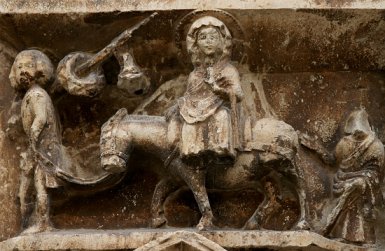
Altamura Cathedral, Puglia, Italy
|
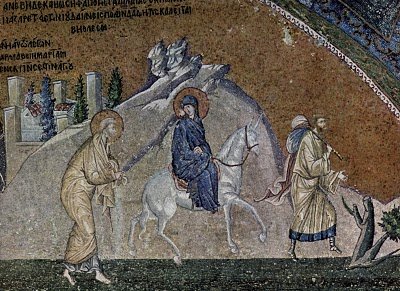
Church of the Holy Saviour in Chora, Istanbul
|
|
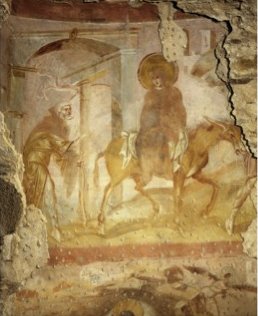
Santa
Maria Foris Portas, Castelseprio
|
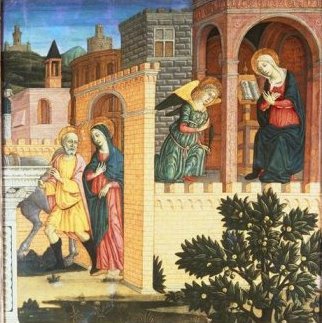
Guidoccio Cozzarelli
Lowe Art Museum Miami
This painting, unusually, shows the Annunciation,
and Joseph and Mary setting off to Bethlehem.
|
The arrival in Bethlehem
The arrival in Bethlehem features occasionally in Flemish art, as
below. The painting from the Met shows a splendidly Disney-like Bethlehem:
the version by Massys is rather more down to earth. Mary and Joseph are in the
background, being turned away from the inn.
The Mosaic from The Church of the Holy Saviour in Chora,
Istanbul, shows a busy scene of Joseph paying his taxes to an officious
looking revenue collector. Nothing changes. |
|
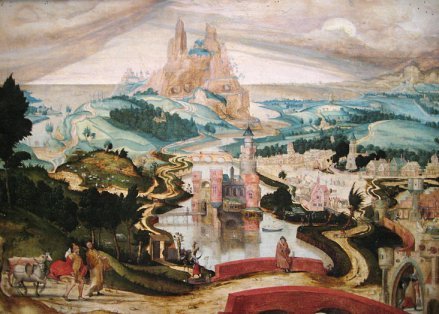
Master LC.( c 1540)
Metropolitan Museum New York.
|
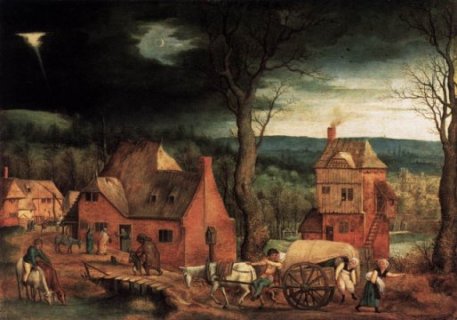
Cornelis Massys
Staatliche Museen, Berlin
|
|
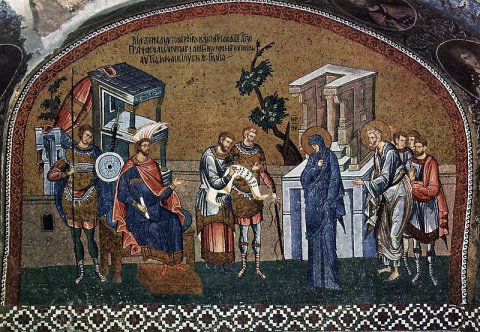
|
|
So does the Journey to Bethlehem have any historical reality, or is
it simply a contrivance to fulfil an Old Testament prophecy? Geza Vermes,
in The Nativity, struggles to find any credible evidence. Herod
ruled until his death in 4 B.C., and as a client king any responsibility
for censuses and tax gathering would have been his, not the Romans. In any
case, Roman censuses were for Roman citizens, and Joseph was not one of
these. The suggestion that a would-be tax payer would need to pay his tax
in the city of his ancestors, not in the city where he had his property,
would have made no more sense then than it does now. |






